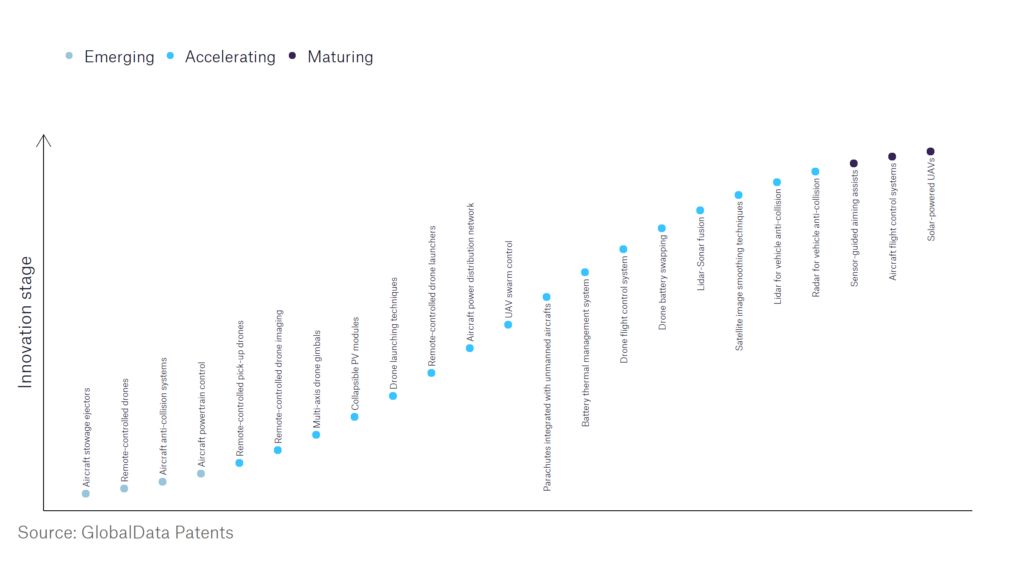[ad_1]
The aerospace and defence industry continues to be a hotbed of innovation, with activity driven by the pressing need for modernisation and the growing importance of emerging technologies such as artificial intelligence and unmanned systems. In the last three years alone, there have been over 174,000 patents filed and granted in the aerospace and defence industry, according to GlobalData’s report on Internet of Things in Aerospace, Defence & Security: Aircraft power distribution network.
However, not all innovations are equal and nor do they follow a constant upward trend. Instead, their evolution takes the form of an S-shaped curve that reflects their typical lifecycle from early emergence to accelerating adoption, before finally stabilising and reaching maturity.
Identifying where a particular innovation is on this journey, especially those that are in the emerging and accelerating stages, is essential for understanding their current level of adoption and the likely future trajectory and impact they will have.
180+ innovations will shape the aerospace and defence industry
According to GlobalData’s Technology Foresights, which plots the S-curve for the aerospace and defence industry using innovation intensity models built on over 262,000 patents, there are 180+ innovation areas that will shape the future of the industry.
Within the emerging innovation stage, aircraft powertrain controls, remote controlled drones, and aircraft anti-collision systems are disruptive technologies that are in the early stages of application and should be tracked closely. UAV swarm control, lidar for vehicle anti-collision, and satellite image smoothing techniques are some of the accelerating innovation areas, where adoption has been steadily increasing. Among maturing innovation areas are sensor-guided aiming assists and aircraft flight control systems, which are now well established in the industry.
Innovation S-curve for Internet of Things in the aerospace and defence industry

Aircraft power distribution network is a key innovation area in Internet of Things
Aircraft power distribution networks are systems that share and regulate the distribution of power across the aircraft. Increasingly complex aircraft designs are requiring power distribution networks to be more advanced and responsive, and capable of routing power around localised faults, to maintain power supply to all parts of the aircraft. The development of the Internet of Things is resulting in smarter power distribution networks.
GlobalData’s analysis also uncovers the companies at the forefront of each innovation area and assesses the potential reach and impact of their patenting activity across different applications and geographies. According to GlobalData, there are 30+ companies, spanning technology vendors, established aerospace and defence companies, and up-and-coming start-ups engaged in the development and application of aircraft power distribution network.
Key players in aircraft power distribution network – a disruptive innovation in the aerospace and defence industry
‘Application diversity’ measures the number of different applications identified for each relevant patent and broadly splits companies into either ‘niche’ or ‘diversified’ innovators.
‘Geographic reach’ refers to the number of different countries each relevant patent is registered in and reflects the breadth of geographic application intended, ranging from ‘global’ to ‘local’.
Safran is one of the leading patent filers in aircraft power distribution networks. In September 2022, Safran launched its electrical engineering centre of excellence. Safran and its subsidiaries have submitted patents relating to the networking of power onboard electric aircraft – a topic of increasingly relevance and interest in the industry. Airbus is the second largest patent filer in this area, with two patents filed in October 2022 relating to ways of cooling power distribution networks on aircraft. Some other key patent filers in the aerospace and defence industry include Boeing, Raytheon Technologies, and Rolls-Royce.
In terms of application diversity, Bombardier leads the pack. Boeing and Textron stood in the second and third positions, respectively. By geographic reach, Groupe Industriel Marcel Dassault held the top position, followed by Safran, Thales, and Groupe Latecoere.
Aircraft power distribution networks are having to adapt in line with the increasing complexity of systems installed onboard aircraft. The development of the Internet of Things is resulting in power distribution networks developing smarter function in real-time monitoring, control and system management.
To further understand how Internet of Things is disrupting the aerospace and defence industry, access GlobalData’s latest thematic research report on Thematic Research – Internet of Military Things.
[ad_2]
Source link








